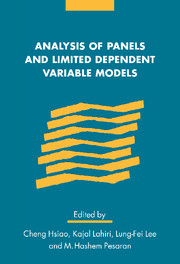Book contents
- Frontmatter
- Contents
- List of contributors
- Foreword
- Introduction
- 1 A note on left censoring
- 2 Autoregressive models with sample selectivity for panel data
- 3 Mixture of normals probit models
- 4 Estimation of dynamic limited-dependent rational expectations models
- 5 A Monte Carlo study of EC estimation in panel data models with limited dependent variables and heterogeneity
- 6 Properties of alternative estimators of dynamic panel models: an empirical analysis of cross-country data for the study of economic growth
- 7 Modified generalized instrumental variables estimation of panel data models with strictly exogenous instrumental variables
- 8 Expectations of expansions for estimators in a dynamic panel data model: some results for weakly exogenous regressors
- 9 Re-examining the rational expectations hypothesis using panel data on multi-period forecasts
- 10 Prediction from the regression model with one-way error components
- 11 Bayes estimation of short-run coefficients in dynamic panel data models
- 12 Bias reduction in estimating long-run relationships from dynamic heterogeneous panels
- CV of G.S. Maddala
- Index
10 - Prediction from the regression model with one-way error components
Published online by Cambridge University Press: 22 September 2009
- Frontmatter
- Contents
- List of contributors
- Foreword
- Introduction
- 1 A note on left censoring
- 2 Autoregressive models with sample selectivity for panel data
- 3 Mixture of normals probit models
- 4 Estimation of dynamic limited-dependent rational expectations models
- 5 A Monte Carlo study of EC estimation in panel data models with limited dependent variables and heterogeneity
- 6 Properties of alternative estimators of dynamic panel models: an empirical analysis of cross-country data for the study of economic growth
- 7 Modified generalized instrumental variables estimation of panel data models with strictly exogenous instrumental variables
- 8 Expectations of expansions for estimators in a dynamic panel data model: some results for weakly exogenous regressors
- 9 Re-examining the rational expectations hypothesis using panel data on multi-period forecasts
- 10 Prediction from the regression model with one-way error components
- 11 Bayes estimation of short-run coefficients in dynamic panel data models
- 12 Bias reduction in estimating long-run relationships from dynamic heterogeneous panels
- CV of G.S. Maddala
- Index
Summary
Econometrics had its origin in the recognition of empirical regularities and the systematic attempt to generalize these regularities into “laws” of economics. In a broad sense, the use of such “laws” is to make predictions – about what might have been or what will come to pass. Econometrics should give a base for economic prediction beyond experience if it is to be useful. In this broad sense it may be called the science of economic prediction.
Lawrence R. Klein (1971)Introduction
Following the work of Balestra and Nerlove (1966) the regression model with error components, or variance components, has become a popular method for dealing with panel data. A summary of the main features of the model, together with a discussion of some applications, is available in Hsiao (1986), Mátyás and Sevestre (1992), Maddala (1993), and Baltagi (1995). However, relatively little is known about prediction from the model. Assuming that all the regression parameters and the error process parameters are known, the form of the optimal (in the sense of minimum MSE predictor) has been obtained by Wansbeek and Kapteyn (1978) and Taub (1979). This was extended to the case of serially correlated error components by Baltagi and Li (1992).
This chapter investigates some potentially important practical problems associated with prediction from the error components regression model.
- Type
- Chapter
- Information
- Analysis of Panels and Limited Dependent Variable Models , pp. 255 - 267Publisher: Cambridge University PressPrint publication year: 1999
- 9
- Cited by



